*This post may contain affiliate links. This means we may make a commission if you purchase an item using one of our links*
Fast telescopes are great for a multitude of things whether capturing brighter astrophotography quickly or viewing the wider expanse of outerspace but, choosing the eyepieces that compliment this faster nature of your telescope can be a little tricky.
So, if you’re looking for a solution to this problem, this article will go over 5 of the best eyepieces for fast telescopes to enhance the astronomy experience with your telescope.
1. Explore Scientific 82 – 122
Table of Contents
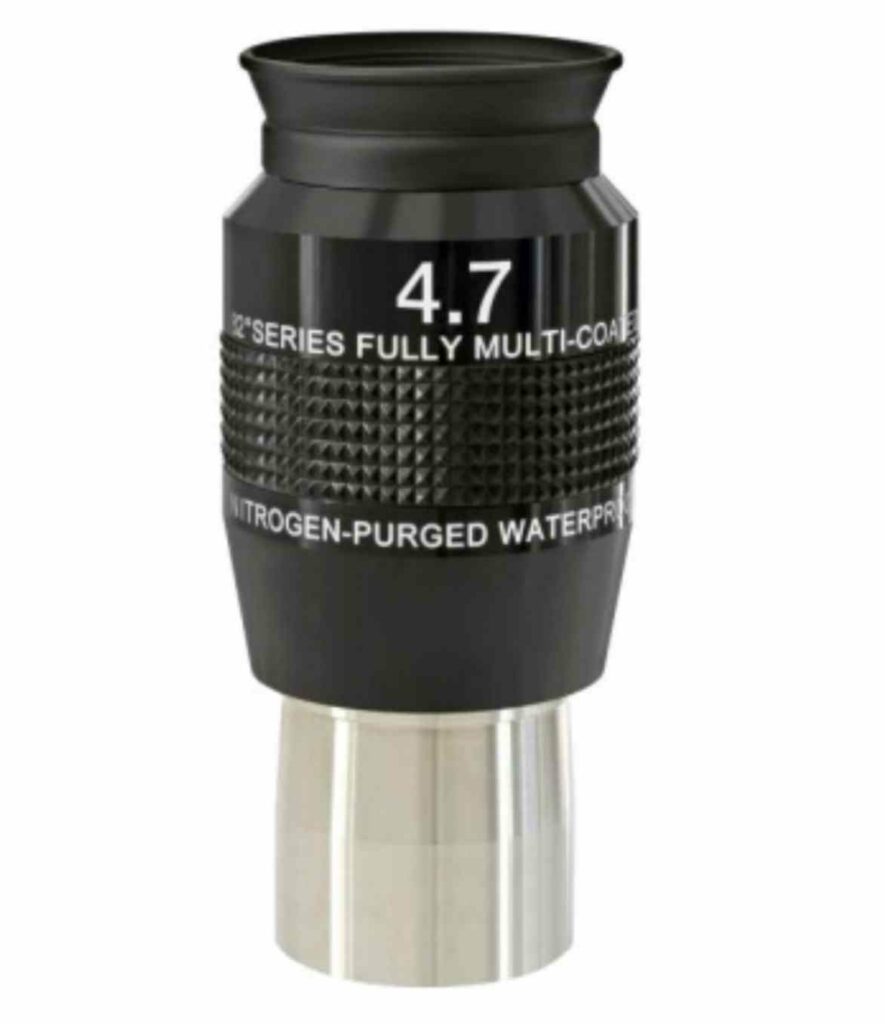
Pros
- Really wide field of view
- Great visuals
- Excellent mid range eyepiece
Cons
- Visual discrepancies near the outer edges
- Not suitable for users who wear glasses due to short eye relief
The Explore Scientific lineup from the 82 to the 122 will provide excellent viewing experience for most who decide to pick them up. Every one of these eyepiece are essentially an ultra wide variant of the 64 degree line up with the field of view (FOV) achieving an extra wide view at 82 degrees and more.
This line up falls within the midrange price range as it provides multilayer coatings on its glass to allow for a highly contrasted and crispy visuals.
Fast telescopes with focal ratios of around f/4.7 and above should do well with these eyepieces as most users with faster telescopes will have very high quality visuals with these explore scientific’s not including the few visual discrepancies like flase colours and aberrations at the far edges of the FOV.
Furthermore, probably the biggest limiting factor for these eyepieces have to do with its very short eye relief where only the 24mm and 30mm versions will be usable for glasses as the have just enough eyerelief being just above the 16mm minimum limit.
Other than that issue the explore scientific 82 should serve you extremely well.
==>Click Here To Check The Explore Scientific 82 – 122’s Pricing On Amazon!
2. Pentax XW’s
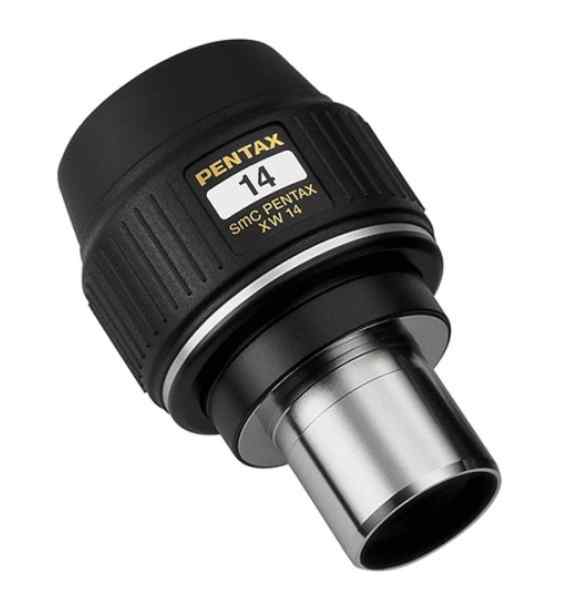
Pros
- Plenty of eye relief for users who wear glasses
- Great visuals, high contrast and crisp images with minimal to low visuals discrepancies
- Waterproof design
Cons
- Quite pricey
- Higher resolution models won’t work great with focal lengths below 600mm
The 1.25″ Pentax XW lineup is also an excellent mid to upper range eyepiece brand that provides an exceptional viewing experience for faster telescopes around the f/4 focal ratio and above. The glass on these eyepieces are high quality and coated to allow the visuals to be both crisp and contrasted.
In regards to the field of view, it is very versatile being marked at 70 degrees making it great for both planetary and wide field viewing. As these eyepieces range between focal lengths of 3.5mm and 40mm the smaller focal length devices won’t work well with telescopes at focal lengths of 600mm or below which will be a bummer for some of you.
Visual discrepancies are kept at a minimum or just not their entirely so, the likelihood of false colours and aberration appearing around the edges of the device is probably not going to bother you at all. To further add to this these eyepieces by Pentax are waterproof too therefore issues with wetness should not result in damage either.
Eye relief, which is a problem for many other great eyepieces on this list once again isn’t a problem for the Pentax XW’s as it stands to have 20mm in eye relief space which is more than enough for users who wear glasses.
Without question, if you’re on the fence about the quality of these eyepieces you shouldn’t be. They’re excellent eyepieces in general and will definitely provide a great visual experience for most fast telescope out there.
==>Click Here To Check The Pentax XW’s Pricing On Amazon!
3. Celestron X-Cel LX
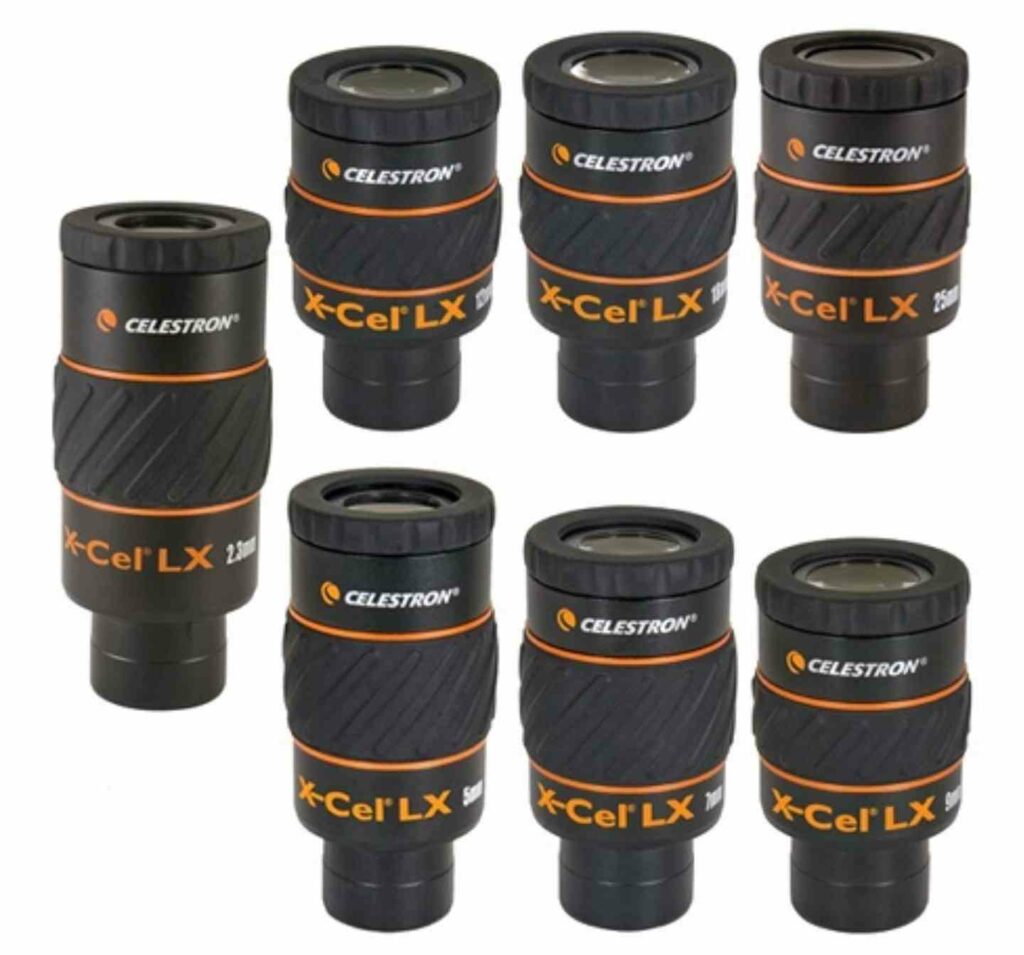
Pros
- Provides crisp and contrasted images at the higher focal length variants
- A good upgrade over the inbox counterparts
- Enough room to use it when wearing glasses due to the adjustable eyecups
Cons
- Clarity and brightness is significantly worse at the lower focal length variants
- Can be hard to focus the eyepiece sometimes
Celestron’s 1.25″ X-Cel LX eyepiece line up is a great upper entry level eyepiece for your telescope, providing crisp and clear visuals and is a clear step up from your typical kellner or plossl eyepieces provided in the box. It has quite the wide FOV for its price at 60 degrees making sure that it’ll provide you with a versatile visual experience.
It also has just enough eye relief to be useable with glasses at 16mm whilst the twist up eyecups allow you to adjust the ends of the X-Cel’s to suit eye comfort needs.
However, do keep in mind that the light gathering ability of these eyepieces do seem to take a significant hit when it comes to the brightness and clarity. Then again it only makes sense, after all physics would dictate a smaller surface will gather less light than the bigger 32mm eyepiece.
Focusing is another issue some users ran into but, as a whole for the price and if you’re looking into the larger focal length eyepieces within this X-Cel line up, for the price you can find these at, I’m sure most of you will find these to be a great upgrade.
==>Click Here To Check The Celestron X-Cel LX’s Pricing On Amazon!
4. Meade 5000 HD – 60
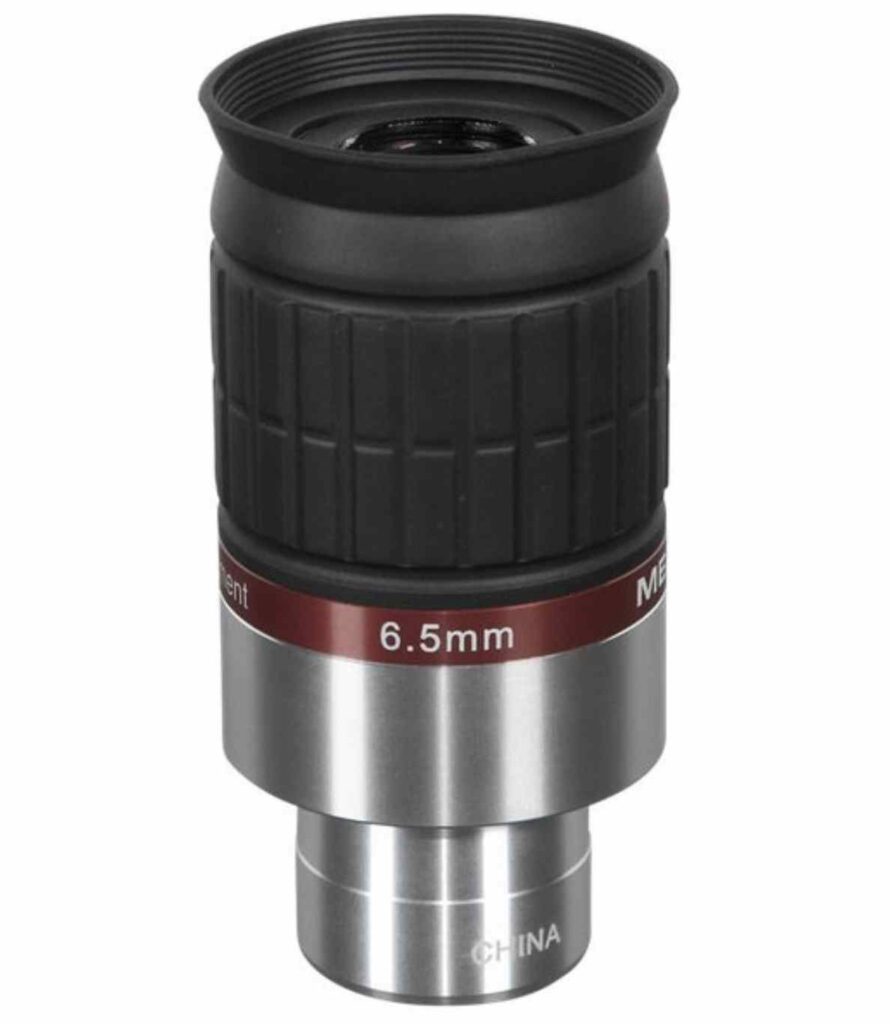
Pros
- Crispy visuals
- Realtively affordable
- Flat glass to reduce visual discrepancies
- 17mm eye relief
Cons
- Not the best eyecup design
- A little astigmatism and sharpness in the outer edges of the device
Meade’s HD – 60 eyepiece line up can be had at a multitude of different focal lengths ranging between 4.5mm – 25mm whilst maintaining a great apparent FOV of 60 degrees.
The glass is coated in 6 elements coating which does mean it will produce sharp and crisp visuals when enough light is gathered but, do keep in mind this is an upper entry level eyepiece series so don’t expect it to perform amazing when the focal lengths decrease. A flat glass design also means the stars on the edges won’t suffer from aberration, which is always a plus.
Of course with 10mm+ eyepieces the visuals will be great, in fact like all the offerings on this post the 5000 series will be noticeably better than any other inbox eyepiece you’ll have tried out previously.
17mm of eye relief also means users with glasses shouldn’t have an issue looking through the device so, basically it will be comfortable for you if you wear glasses.
For the price you can get the 5000 HD – 60 series, you do get a quality eyepiece, good build quality, crisp visuals and a solid FOV. If you decide to pick this up for your fast telescope, I’m sure that it’ll certainly impress you.
==>Click Here To Check The Meade 5000 HD – 60’s Pricing On Amazon!
5. Vixen HR 1.6mm – 3.4mm
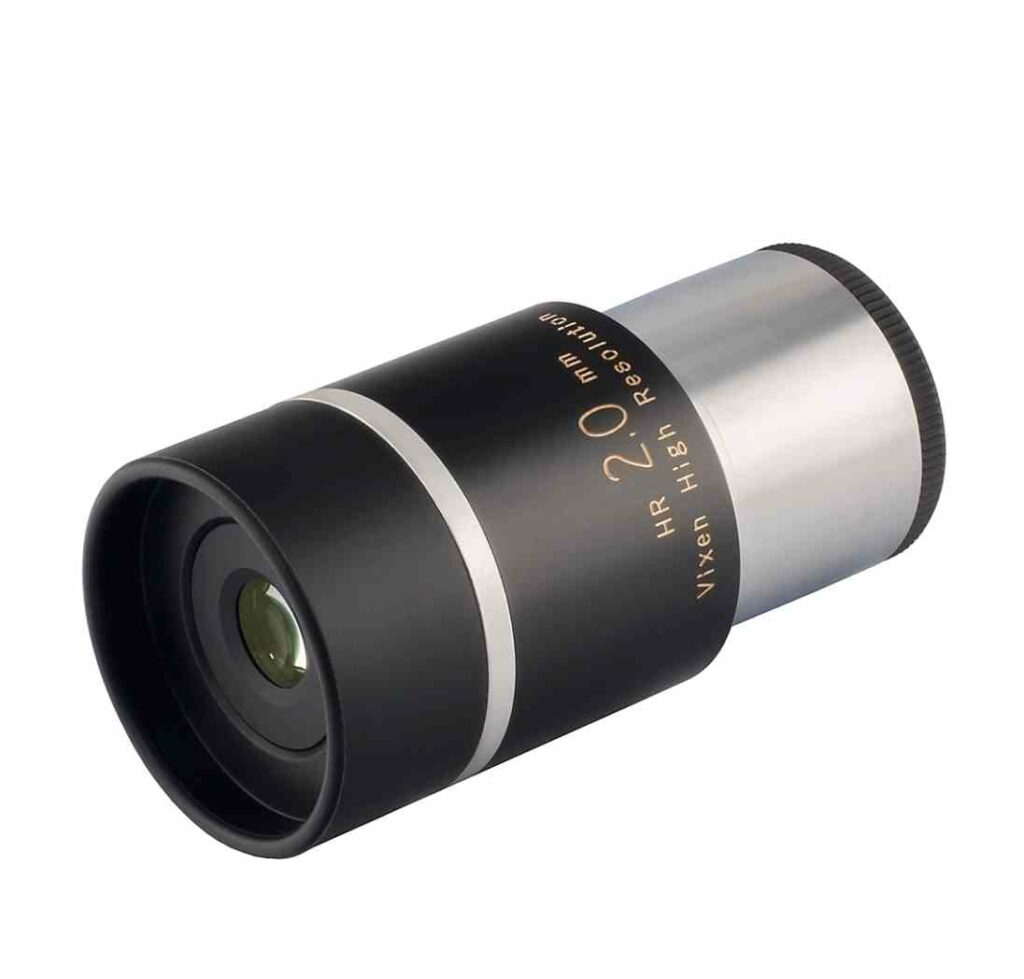
Pros
- High quality and sharp visuals
- Great for planetary viewing
- Great contrast
- 99% transmission rate allowing for maximum detail being captured
Cons
- Really narrow field of view at 42 degrees
- Only high resolution eyepieces are available
- Small eye relief
If you’re willing to stretch the wallet a little and gain access to an eyepiece that has both high transmission rate of the light gathered due to the AS coating on the lens, blackened inner edges, sharp and high resolution images, the vixen will likely serve you very well.
These 1.25″ accessories are great for planetary viewing for telescopes around the 6-8 inch aperture and with around a f/4 focal ratio, which basically means these Japanese made accessories will be more than capable of providing an excellent viewing experience for mid sized faster telescopes.
With that being said these eyepieces are also very small with focal ratio ranging from 1.6mm to 2.4mm so, they don’t have the best eye relief, which in this case is around 10mm. The field of view at only 42 degrees also make these eyepieces as more of a planetary viewing eyepiece however, if you’re looking for a high resolution eyepiece, a narrower field of view is just how it almost always is.
Nevertheless, if you’re after a truly high power and quality eyepiece to get the maximum magnification out of your fast telescope, the Vixen HR line up will not dissapoint.
==>Click Here To Check The Vixen HR 1.6mm – 3.4mm’s Pricing On Amazon!
Maybe Look Into Televue’s 2x/3x Barlow Lens
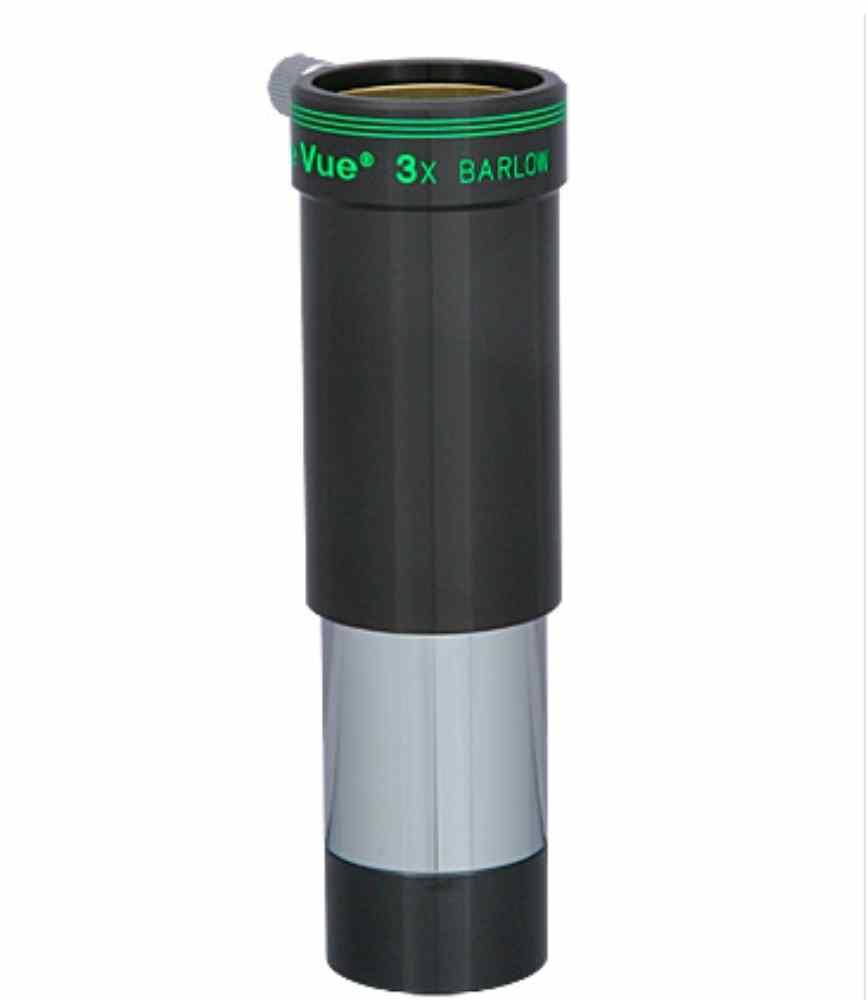
I know that Televue’s barlow lenses aren’t technically eyepieces but what they do provide is some of the best add on features to get even more out of one of your more higher quality eyepieces.
Televue are in and of itself a luxury eyepiece and barlow brand so these barlows are definitely on the pricer side but, if you want one that is both free from visual discrepancies and is colour accurate to boot, a 2x or 3x Barlow will go a long way in providing you with a great viewing experience without breaking the bank on Televue’s great but expensive eyepiece line up.
Granted you will need to purchase one of the eyepieces mentioned above to make the most out of this barlow lens with your fast telescope but, investing in them along with one of the cheaper options mentioned above is a great alternative to just splashing the cash entirely on expensive premium fast telescope eyepiece.
==>Click Here To Check The Televue’s 2x/3x Barlow’s Pricing On Amazon!
What Makes A Telescope A Fast One?
A fast telescope is simply put a device that gathers light at a much quicker rate than other alternatives. This is as a result of a smaller focal length in combination with a larger aperture. For example a telescope with an aperture at 200mm and focal length of 800mm resulting in a focal ratio of f/4 would be a really fast telescope so to speak.
A faster telescope in turn would require less exposure to an objects light source in order to view it. Generally speaking telescopes with focal ratios of f/7 and below can be categorised as fast.
What Are The Positives And Negatives Of Fast Telescopes?
Faster telescopes are more capable of producing lower magnification levels which means that if you want to observe an object much closer to you, they’ll be better for this.
On the other hand due to the wider field of view and the brisk pace at which light reaches your eyepiece unlike slower systems, observing planets will be much noisier in quality. Although if you’re willing to spend money on larger more powerful fast telescope, faster scopes will perform equally if not better than slower systems.
Faster systems are also preferred for astrophotography as the exposure needed to capture an image will be much faster.
How Can Eyepieces Help With The Visuals Of A Fast Telescope?
Eyepieces are essentially used, primarily the higher end ones, to correct the visual issues that faster telescopes suffer from like chromatic aberration for refractors or coma for reflectors.
These eyepieces are then used to further sharpen or increase the quality of the planets or stars you’ll be observing.
What Is The Field Of View?
The field of view describes how much of the sky you can see with an eyepiece with the larger the number the more you’ll be able to observe nearer the edges of the eyepieces glass.
Of course there is more to field of view than just numbers as in practical usage the field of view can be labelled as the apparent field of view (AFOV) and the true field of view (TFOV).
AFOV is simply the field of view you’ll see whilst looking through the eyepiece on its own whilst the TFOV Is determined by dividing the AFOV into the magnification of your telescope. For example if you had an eyepiece with a 50 degree AFOV and the eyepiece was able to produce a 100x magnification, the TFOV would in turn be 50/100 which 0.5.
This 0.5 degrees is the diameter of the circular view that your eyepiece will be able to observe, which with 0.5 degree example means you’d be able to fit the moon within the circle of the example eyepiece.
A larger field of view does in turn mean you’ll be able to observe a lot more of the night sky without having to adjust your setup to do so.
What Is The Focal Length Of An Eyepiece?
The focal length of an eyepiece determines how much magnification it’ll provide for your telescope after doing a few calculations.
Magnification in telescopes is determined by dividing the focal length of the eyepiece, in this example let’s say 10mm, into the focal length of your fast telescope of around 1000mm.
After calculating the numbers you’ll find that this eyepiece will produce visuals at a 100x magnification. A 25mm eyepiece would result in 40x magnification when divided into 1000mm and so on. In short, eyepieces with shorter focal lengths do provide more power however, as a result brightness will be sacrificed due to their smaller footprint.
Conclusion
Hopefully this list of ours has helped you out in picking up an eyepiece suited for your astronomy needs. It’s certainly not an easy thing to shop for considering all the options available out.
The quality of your eyepiece will ultimately determine the clarity at which you’ll be able to stargaze so narrowing it down to a few of the best overall ones should hopefully reduce the extra stress of having to find which eyepiece is worth it on your own.







